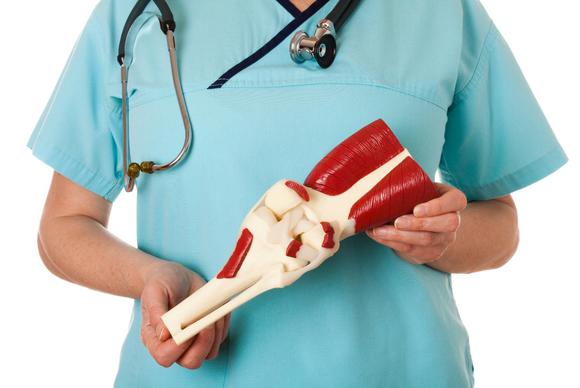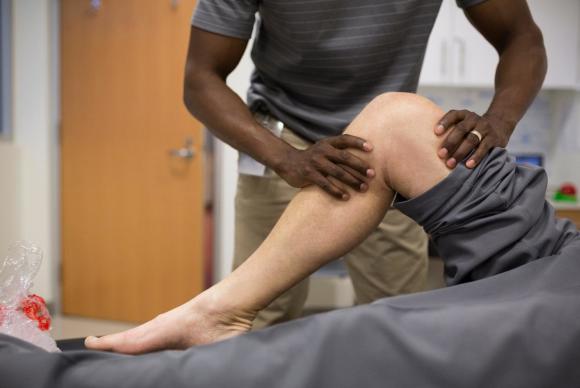View Providers

A Common Way to Relieve Knee Pain
The knee joint is the largest joint in your body. It bears your body weight, supports movement and acts as a shock absorber for the body. For people whose knee pain is changing the way they live, a knee replacement is a lifesaver. The medical name for knee replacement is knee arthroplasty. The goal is to restore pain-free range of motion and full function of your knee. Learn more knee replacement options so you know what to expect and what to ask your orthopedic surgeon.

1. A Knee Replacement Is for Pain That Interferes With Your Life
Your doctor may suggest a knee replacement when your knee problems interfere with your life. Pain and stiffness that limit your activities, such as walking or getting in or out of a chair, is a reason to consider surgery. You also may need surgery if you have pain even at rest or during the night. Your doctor will need to know that you have tried other treatments — medicines and physical therapy — without relief before recommending surgery.

2. There Are Different Types of Knee Replacements
Most knee replacements are total replacements that remove the entire knee joint. In some cases, doctors may recommend a partial replacement. This replaces only one of the three knee compartments. There are various designs and types of knee replacement implants, including cemented and uncemented implants. Each has advantages and disadvantages. Ask your doctor about what’s right for you. Specifically, ask your doctor what brands of implants he or she uses and the typical surgical results from using those particular brands and materials.

3. An Artificial Knee Lasts About 15 Years
The vast majority of knee replacements still function well 15 years after surgery. You can help prolong the life of your artificial knee by maintaining a healthy weight. People who are overweight have a higher rate of joint failure. You should also get regular exercise to strengthen and stabilize your knee and take care to avoid falls.

4. Knee Replacement Surgery Can Be Minimally Invasive
Today, many doctors perform a minimally invasive version of knee replacement rather than traditional open surgery. In either case, a knee replacement is major surgery. Recovery time for minimally invasive surgery, which uses several button hole-sized incisions, will likely be shorter than the open procedure, which uses a larger incision. Not everyone qualifies for this type of surgery. Ask your doctor if you are a good candidate for minimally invasive knee replacement.

5. The Majority of Knee Replacements Are Successful
Most knee replacements are highly successful, but there are risks. They include bleeding, infection, blood clots, continued knee pain, loosening of the new joint, and dislocation. To guard against blood clots, doctors often prescribe blood thinners — anticoagulants — for several weeks after surgery. Protect your knee by maintaining your leg strength with regular exercise. You also need to guard against falls.

6. You’ll Have Several Weeks of Physical Therapy
You will likely stay in the hospital for several days after a knee replacement. Recovery will involve several weeks of physical therapy and rehabilitation. This will help you improve your mobility and joint function. Some people need to stay a short time in a rehabilitation center after leaving the hospital. Full recovery can take up to three months. Talk to your doctor and find out what you can expect based on your type of knee replacement.

7. Preparing Your Home Will Make Things Easier
When you are recovering at home, you need to prevent falls and arrange things so that you can take care of your daily activities without damaging your new knee. Consider adding safety bars to your shower and toilet area. Get a raised toilet seat and a shower bench. Also, consider attaching a shower hose or use a handled sponge to bathe. Use a reacher to pick up objects without bending over. Make sure stair railings are stable and take up area rugs during recovery. Your doctor’s office can arrange a home consultation to help you.

8. You May Have to Switch Out Running in Favor of Low-Impact Activities
It may be hard to remember what life was like before your knee problems. The goal of knee replacement is to get you back to that time. But realize that your new knee will feel different at first. It may feel stiff compared to your natural joint and you may hear clicking sounds when bending your knee. With physical therapy, most people return to pain-free normal daily activities. Doctors usually recommend avoiding running and other high-impact sports. You can expect to return to golf, walking, biking, hiking, swimming, and other low-impact sports and activities.




